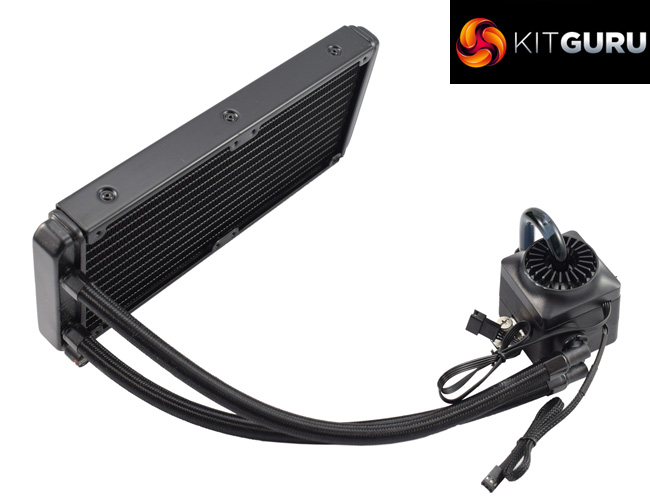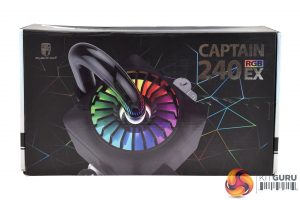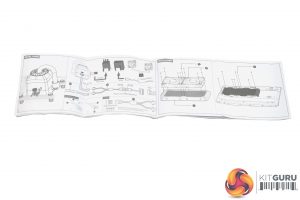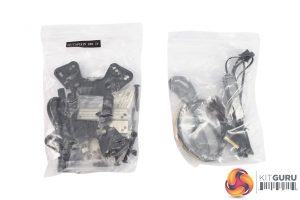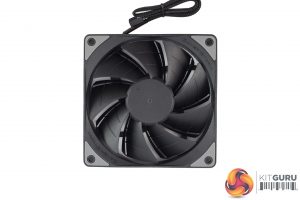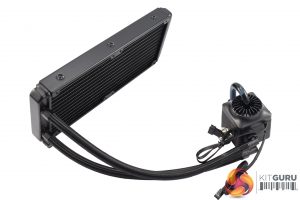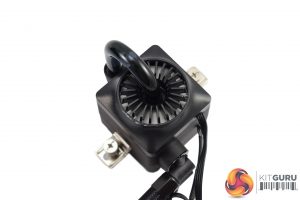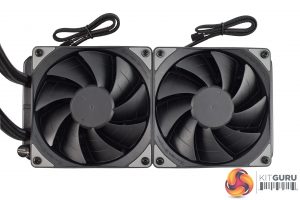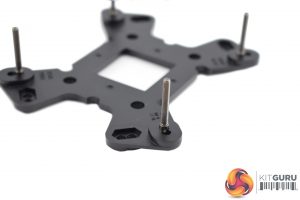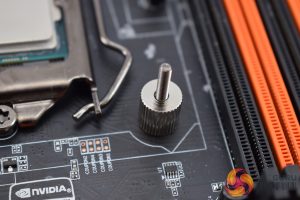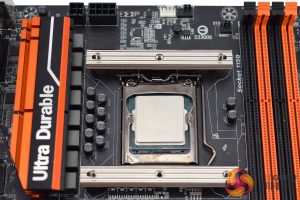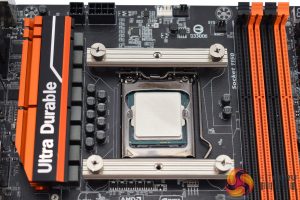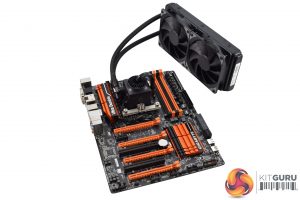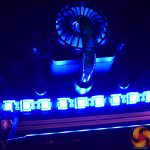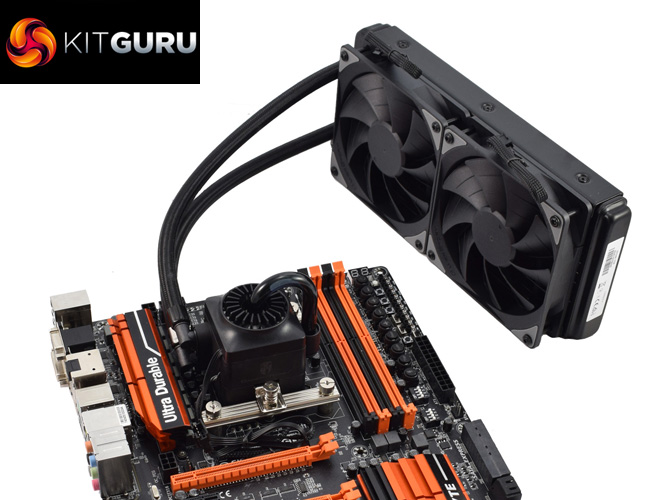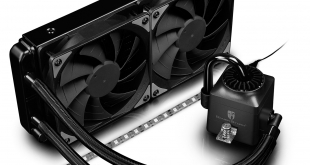
Over the past couple of years we have looked at various Deepcool liquid coolers – from the original Captain 240, to the updated 240 EX as well as the 120 EX. Today we assess the Captain 240 EX RGB, the principal difference (when compared to the previous model) being the RGB lighting. In 2017, what more could you want?
The new Deepcool Captain EX RGB series is available in three of the most common liquid cooler sizes: 120mm, 240mm and 360mm, so there should be something for everyone here. In this review are primarily focusing on the 240 EX RGB, however we have also included performance figures for the other two models as well.
Specification
- LED Strip: 350mm × 1 pc
- Fan Dimensions: 120X120X25mm(2PCS)
- Net Weight: 1343±10g
- Fan Speed: 500±200-1800±10%RPM
- Fan Air Flow: 153.04CFM(MAX)
- Fan Air Pressure: 3.31mmH2O(MAX)
- Fan Life Expectancy: 50000 hours
- Fan Noise Level: 17.6~31.3dB(A)
- Fan Bearing Type: Hydro Bearing
- Fan Connector: 4Pin
- Fan Rated Voltage: 12VDC
- Fan Rated Current: 0.12A
- Fan Power Consumption: 1.44W
- Main system Dimensions: 92.5X93X85mm
- Radiator Dimensions: 274X120X27mm
- Radiator Material: Aluminium
- Pump Life Expectancy: 120000 hours
- Pump Connector: 3Pin
- Pump Operating Voltage: 6~13.8VDC
- Pump Rated Voltage: 12VDC
- Pump Speed: 2100±10%RPM
- Pump Current: 0.15A(Max)
- Pump Power Consumption: 1.8W
- Tubing Length: 310mm
The Deepcool Captain 240 EX RGB ships in a dark box with unmissable RGB accents – welcome to 2017!
Inside, the manual is quite brief but is straightforward and easy to follow.
All of the installation hardware comes in one big bag, but there are labelled bags inside for different sockets which is very helpful. The EX RGB coolers also come with 1x RGB strip (2 strips for the 360mm model) which will sync directly with the pump's lighting.
The included fans are not RGB, however, but they are colour-neutral so their appearance will not interfere with the lighting you configure.
The liquid cooler itself is pretty conventional, and aside from the all-black aesthetic, it is identical to the original Captain 240 EX – so the radiator measures 27mm thick while the pump retains its unique ‘reactor-style' appearance with the exposed tubing.
The difference with the pump, though, is the RGB lighting. This is evident when looking beneath the blades on the top of the pump, as you can see the white-ish LED housing which will illuminate any colour of your choice.Here I will walk you through the installation process. It is worth noting we test using a Z97 motherboard – socket LGA 1150. The process below reflects that.
All three coolers share the same installation method.
First of all, get the fans out of the way by screwing them onto the radiator.
After that, we can prepare the backplate – four long screws need to be attached and these clip onto the backplate to prevent them falling out.
With the backplate ready, go ahead and place its screws through the motherboard's socket holes.
Four spacers are then used to keep the backplate and screws in place.
Now we are ready to place the two rails on-top of the screws and spacers. It is important they are placed horizontally to prevent any clearance issues when mounting the cooler itself.
The rails are then secured with four small thumbscrews/nuts.
After that, the pump is ready to be mounted – its pre-attached bracket simply screws into the rails, and that is job done!
The process is identical to the previous 240 EX coolers and it is pretty simple and straightforward so we have no complaints.
If the above gallery is not displaying, please whitelist us via your ad blocker as they are known to interfere with our website code.
Before moving on, we should look at the RGB lighting – it is, after all, a key feature of the new series. The lighting can be controlled one of two ways – either via a 4-pin RGB header on your motherboard, or using the small bundled controller. I had to use the hardwired controller as our test motherboard does not have a 4-pin RGB header.
Overall, this controller is pretty basic – it lets you change the brightness, mode and speed (for the colour cycle mode) and that is it. It is not as sophisticated as, say, EVGA's CLC series which connects via USB but it does the job. Still, for the best experience, it would be ideal to use the cooler with a RGB-capable motherboard.To test all CPU coolers, we devised an easily repeatable test with no variables other than the coolers themselves. This ensures that figures from every cooler we test are comparable with each other.
Test rig
Using an open-air test bench, we deploy an Intel Core i7-4790K plugged into a Gigabyte Z97X-SOC Force motherboard. Alongside this is 16GB of 2400MHz Corsair Vengeance DDR3, as well as a 120GB OCZ Trion 150 SSD. Powering everything is a Corsair RM750x PSU.
The test process
Testing coolers involves taking a total of 4 temperature readings per cooler. First, we measure the idle temperature of the i7-4790K at stock speeds (turbo boost disabled), before measuring its temperature under load at stock speeds. Next, we overclock the CPU to 4.5GHz using a 1.3 Vcore, ensuring greater heat output. In its overclocked state we then measure the idle and load temperatures of the CPU again. The figures we present are temperature deltas – meaning we take each temperature reading and minus the ambient temperature from it. This allows us to test in an environment that is not temperature-controlled.
To ward off potential comments or questions, we know 4.5GHz using a 1.3 Vcore is not the ‘best’ overclock – this particular CPU could reach that frequency at closer to 1.25 on the Vcore, which is more efficient. That is not the point, however. We are trying to stress the coolers to see how they deal with excess heat … hence the higher than necessary Vcore.
Where possible, each cooler’s fans are plugged directly into the motherboard using the CPU_Fan or CPU_Opt headers. Some AIOs, however, ship with their own fan controllers or PWM hubs. If we are unable to plug the fans directly into the motherboard, it is specified in the performance section of the review.
An idle reading comes from leaving Windows on the desktop for 15 minutes. A load reading comes from running Prime95’s (version 26.6) Small FFTs test for 15 minutes – enough time for temperatures to plateau.
Noise output
Unfortunately I am unable to accurately measure the sound output of CPU coolers using a digital sound meter. This is because I am based alongside a busy road (with high ambient noise levels). Using a sound meter is, as such, not possible as there are variables out of my control. However, I will try my best to subjectively describe the noise output in a helpful manner.Temperatures
All temperature charts are sorted with lowest load temperatures at the top.
I must admit, overall performance of the three Captain EX RGB coolers is a bit disappointing. The 240 EX RGB is very average at stock clocks, but with an overclocked CPU it recorded the highest delta temperature of any 240mm liquid cooler we have tested.
The 360mm model does fare better – as we would certainly hope – but even for a 360mm liquid cooler, it is still bettered by a number of 240mm models which is not ideal.
Lastly, the 120 EX RGB definitely struggles to the point where even a fairly basic air cooler manages to outperform it.
Acoustics
The upside of the relatively lacking thermal performance is acoustics. Neither of the three coolers I tested were noisy – in fact, all three were relatively quiet compared to the competition. Even when running an overclocked CPU at 100% load, I got the distinct impression that the fans were ‘holding back' and not running full pelt. This is obviously good if you want a quiet system, but the cost is definitely thermal performance as we noted above.The Deepcool Captain 240 EX RGB is a new RGB liquid cooler from Deepcool.
Essentially, it is a refresh of the Captain 240 EX, but with RGB lighting this time, whereas previous models had fixed red or white lighting. The new RGB range is also available in 120mm and 360mm sizes.
Because it is essentially the same thing as a 240 EX cooler, the installation process is identical and that is definitely a good thing. Users will be up and running in no time and the whole process is very frustration-free.
Thermal performance is a bit disappointing, though. Both the 240mm and 360mm models aren't bad, they are just very average and won't convince you to change cooler for the temperatures alone. The 120mm model, however, is bested by some very basic air coolers so is far from appealing.
The upshot of the mediocre thermal performance is acoustics – all of the coolers are actually very easy on the ears so users looking for a ‘quiet-but-slightly-warmer' setup might well be tempted by the EX RGB range.
Overall, the Deepcool Captain 240 EX RGB, along with its 360mm counterpart, is a good product – though it depends what you are looking for. If you want the best raw thermal performance, you would should probably look elsewhere – but for the quiet fans, funky RGB lighting and an easy installation process, Deepcool's new range is definitely worth buying.
You can buy the 120mm model for£96.02 from CCL HERE, while the 240mm model costs £110.78 HERE. The 360mm model is not yet available.
Discuss on our Facebook page, over HERE.
Pros
- Looks good.
- Easy to install.
- Nice and quiet.
- RGB lighting adds versatility.
Cons
- Thermal performance is very average.
- RGB controller is not the most sophisticated.
KitGuru says: The Captain EX RGB won't blow anyone's socks off due to its thermal performance, but the coolers are quiet, good looking and easy to install.
Be sure to check out our sponsors store EKWB here
 KitGuru KitGuru.net – Tech News | Hardware News | Hardware Reviews | IOS | Mobile | Gaming | Graphics Cards
KitGuru KitGuru.net – Tech News | Hardware News | Hardware Reviews | IOS | Mobile | Gaming | Graphics Cards


